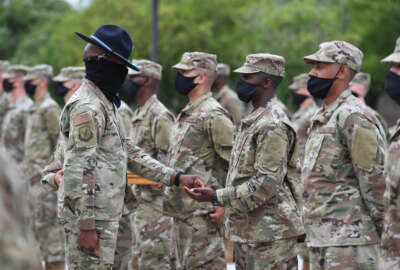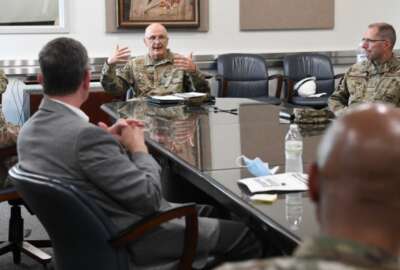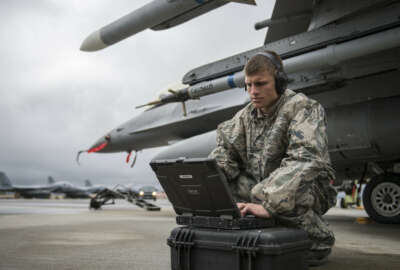
Air Force schools embracing lessons from telework during COVID
Like with telework, the Air Force may never go back to teaching the same way again.
There has been a lot of talk recently about how the military is embracing telework during the coronavirus and will continue to after the pandemic is over, but the Air Force is learning how to better teach its airmen during COVID as well.
Lt. Gen. James Hecker, commander and president of Air University, and Maj. Gen. Andrea Tullos, commander of Second Air Force, told reporters Monday that virtual training has changed the way the service approaches everything from basic training to intelligence classes.
“As we come out of COVID, we get a vaccine, which will be a while from now, we have to take a hard look and see what we’re going to continue doing virtually and what we’ll resort back to doing in-residence,” Hecker said. “For the long term, we’ve proven that we can do all this stuff virtually. But how good is it? Is it 80% as good as being in-residence, or is it 100% as good? Or it maybe it is even better.”
Hecker said the Air University has learned to be agile in the coronavirus environment. Previously, airmen lived on base for training or conducted distance learning (correspondence type courses) for some classes. Now the school has created two other hybrid ways of teaching students: virtual local and virtual remote.
Virtual local is for when airmen are already in-residence, but something happened where they need to work virtually — think of a situation like one student being diagnosed with coronavirus.
Virtual remote means teachers can instruct from their homes to airmen in their homes or on their bases.
“We make sure that we can change between them anytime that we need to,” Hecker said. “For instance, at the Air War College, we’re currently doing that in residence. We have a little bit over 200 students. If somebody feels a little bit sick in the morning, instead of exposing everybody else, they will stay at home. We can have them virtually come into the classroom. They’re seeing exactly what the folks are seeing in the classroom, they’re just doing it from their house.”
For the future, Hecker said this could work for someone who is on maternity leave and really wants to take a certain course.
Tullos said adding agility to courses is becoming a part of life now, not only with COVID, but with other personal and global events.
Back in March and April, there were some significant emotional events across our cadre and our instructors, because that never used to happen,” she said. “You plan to follow the schedule, you followed the plan of instruction. Change was difficult. And now our trainees take change like it’s just the fact of life.”
For example, a hurricane recently hit Keesler Air Force Base in Mississippi. Tullos said the students were able to go on with classes while switching to MREs for meals and continued to social distance.
“I honestly believe that would not have been the case a year ago,” Tullos said. “Those lessons that they’re learning are going to translate into everything we ask of them as an airman in the military. Change is a constant, and it can be very stressful. I think this generation, because I believe this will extrapolate beyond the military, is going to become flexible in ways that will be very beneficial for the country in the long term.”
The Air Force schools are also considering how they are using real estate. The Air University’s larger seminars have had to switch to doing two classes instead of one to promote social distancing. Other classes have moved to larger auditoriums.
Hecker said as the Air Force moves forward it will make decisions on what will be taught virtually, and what will be taught in person. That may free up some classroom space. However, current classes are able to continue with the new accommodations.
Back in May, the Air Force moved some of its basic training to Keesler to promote social distancing.
The Air Force traditionally sends recruits only to Joint Base San Antonio-Lackland in Texas for basic training. Lackland usually takes in between 650 and 800 recruits a week, but was forced to reduce that number to 460 in March.
“The Air Force has asked us to train up to 9,400 active duty between now and the end of the fiscal year and a total of 12,800 total force during that time,” Tullos said in May. “That’s the rough order of magnitude. We’ll put out about 700 a week so if you do the math, minus the 60 at Keesler, the rest will be at Lackland.”
The Air Force has now pulled back from that practice to do a 90-day assessment and then will evaluate the needs during COVID to decide if training is still needed at Keesler.
Copyright © 2025 Federal News Network. All rights reserved. This website is not intended for users located within the European Economic Area.
Scott Maucione is a defense reporter for Federal News Network and reports on human capital, workforce and the Defense Department at-large.
Follow @smaucioneWFED
Related Stories





